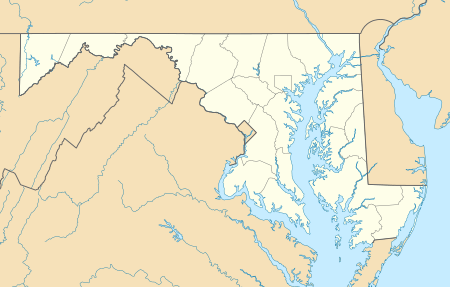Oxon Hill Manor
Oxon Hill Manor is a neo-Georgian house of 49 rooms, located at Forest Heights, Prince George's County, Maryland. It was designed in 1928 for Sumner Welles (1892-1961) by the Washington architect, Jules Henri de Sibour (1872-1938). It was built in 1929, and consists of a two-story main block of Flemish bond brick and a northern wing. Also on the property are two outbuildings contemporary with the house; a five-car garage and attached manager's quarters and greenhouse, and a stable. There are also formal gardens on the grounds.[2]
Oxon Hill Manor | |
Oxon Hill Manor, December 2010 | |
  | |
| Location | 6701 Oxon Hill Rd., Forest Heights, Maryland |
|---|---|
| Coordinates | 38°47′38″N 77°0′21″W |
| Area | 55 acres (22 ha) |
| Built | 1928 |
| Architect | de Sibour, Jules-Henri |
| Architectural style | Colonial Revival, Neo-Georgian |
| NRHP reference No. | 78003117 [1] |
| Added to NRHP | June 9, 1978 |
History
The Oxon Hill Manor property has a strong historical association. The colonial-era Addison family, active in the development of Prince George's county and in the colonial government, built a mansion on the property in 1711. In 1778, Thomas Hawkins Hanson, nephew of John Hanson, acquired the property. John Hanson died at Oxon Hill Manor on November 22, 1783, and was buried on the property. Walter Dulaney Addison who was for a time Chaplain of the Senate lived here and conducted a school here.[2]. His son Lloyd Dulany Addison would migrate to Kentucky then to Mobile, Alabama, becoming socially involved in the city. He then moved onto New Orleans, Louisiana, becoming a partner at Bullitt, Miller & Co., and founding the Mistick Krewe of Comus and The Pickwick Club.
After a period of ownership by the Berry family, in 1895, the original Oxon Hill Manor burned. In 1927, the property was bought by Sumner Welles, U.S. Undersecretary of State, who built the present manor house. Franklin D. Roosevelt and possibly Sir Winston Churchill were guests there.[2] It was later the home of Fred Maloof, a wealthy oilman, timberland owner, and art collector who established a museum for fine art and John Hanson memorabilia, before the property came under the control of the Maryland-National Capital Park and Planning Commission.[2]
It was listed on the National Register of Historic Places in 1978.[1]
Gallery
- Front Facade, December 2010
- Front Entry Detail, December 2010
- John Hanson Obelisk, December 2010
| Wikimedia Commons has media related to Oxon Hill Manor. |
References
- "National Register Information System". National Register of Historic Places. National Park Service. March 13, 2009.
- Mary Fraser dePackah and Pamela James (July 1976). "National Register of Historic Places Registration: Oxon Hill Manor" (PDF). Maryland Historical Trust. Retrieved 2015-08-01.
Further reading
- Maryland Historical Magazine, Baltimore: Maryland Historical Society, 1919, p. 397, retrieved 2008-04-15
- Murray, Elizabeth Hesselius (1895), One hundred years ago: or, The life and times of the Rev. Walter Dulany Addison, retrieved 2008-04-15
- Richardson, Hester Dorsey (1913), Side-lights on Maryland History, Williams and Wilkins company, p. 3, retrieved 2008-04-15
- Tyler, Lyon Gardiner, ed. (1915), Encyclopedia of Virginia Biography, Lewis Historical Publishing Co., p. 20, retrieved 2008-04-15
External links
- Oxon Hill Manor, Prince George's County, Inventory No.: PG:85A-9, including photo in 1995, at Maryland Historical Trust website
- Historic American Buildings Survey (HABS) No. MD-301, "Oxon Hill Manor, 6701 Oxon Hill Road, Oxon Hill, Prince George's County, MD", 28 photos, 14 data pages, 1 photo caption page
- HABS No. MD-301-A, "Oxon Hill Manor, Grounds", 6 photos, 1 photo caption page
- HABS No. MD-301-B, "Oxon Hill Manor, Manager's Residence, Garage & Greenhouse", 3 photos, 1 photo caption page
- HABS No. MD-301-C, "Oxon Hill Manor, Stable", 2 photos, 1 photo caption page
- Site Summary: 18PR175 Oxon Hill Manor /Addison Plantation

